Invaders from Mars 4K Blu-ray Movie
HomeInvaders from Mars 4K Blu-ray Movie 
Standard Edition / 4K Ultra HD + Blu-rayIgnite Films | 1953 | 78 min | Not rated | Jul 11, 2023
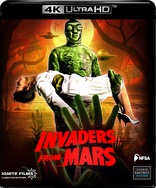
Movie rating
6.8 | / 10 |
Blu-ray rating
| Users | 0.0 | |
| Reviewer | 4.0 | |
| Overall | 4.0 |
Overview
Invaders from Mars 4K (1953)
One night, young David McLean sees a spaceship crash into a nearby sandpit. His father goes to investigate, but comes back changed. Where once he was cheerful and affectionate, he's now sullen and snarlingly rude. Others fall into the sandpit and begin acting like him: cold, ill-tempered and conspiratorial. David knows that aliens are taking over the bodies of humans, but he'll soon discover there have been far more of these terrible thefts than he could have imagined. The young doom-monger finds some serious help in a lady doctor and a brilliant astronomer. Soon they meet the aliens: green creatures with insect-like eyes. These beings prove to be slaves to their leader: a large, silent head with ceaselessly shifting eyes and two tentacles on either side, each of which branches off into three smaller tentacles. It's up to the redoubtable earth trio to stop its evil plans.
Starring: Helena Carter, Arthur Franz, Jimmy Hunt, Leif Erickson, Hillary BrookeDirector: William Cameron Menzies
| Horror | Uncertain |
| Sci-Fi | Uncertain |
Specifications
Video
Video codec: HEVC / H.265
Video resolution: 4K (2160p)
Aspect ratio: 1.37:1
Original aspect ratio: 1.37:1
Audio
English: DTS-HD Master Audio 2.0 Mono (48kHz, 24-bit)
Spanish: DTS-HD Master Audio 2.0 Mono (48kHz, 16-bit)
Subtitles
English SDH, French, German, Italian, Japanese, Korean
Discs
Blu-ray Disc
Single disc (1 BD)
4K Ultra HD
Playback
Region A (B, C untested)
Review
Rating summary
| Movie | 3.5 | |
| Video | 5.0 | |
| Audio | 4.0 | |
| Extras | 4.0 | |
| Overall | 4.0 |
Invaders from Mars 4K Blu-ray Movie Review
Gee whiz indeed.
Reviewed by Jeffrey Kauffman June 29, 2023Invaders from Mars and the Byron Haskin / George Pal 1953 version of The War of the Worlds premiered within just a couple of days of each other, albeit on different continents, and perhaps due to the fact that this film was reportedly rushed into production to beat the Haskin - Pal effort to theaters, there are some curious stylistic parallels between them, despite the film currently under review being rather famously designed and directed by William Cameron Menzies. Compare, for example, the "hills" on which the climactic battles in both films are fought, and there's a noticeable but arguably coincidental similarity between the two set designs and even some elements of the cinematography and framing. As much as their almost simultaneous releases and obviously tethered plot mechanics may make Invaders from Mars and The War of the Worlds kind of likely bedfellows, I'd argue that a much more interesting comparison of productions might be between this film and one which came out around three years later, Don Seigel's unforgettable 1956 version of Jack Finney's Invasion of the Body Snatchers. Consider the fact that both Invaders from Mars and Invasion of the Body Snatchers involve some kind of interloping presence (admittedly, much as with The War of the Worlds), but perhaps more importantly, that the alien siege is uncovered by a hapless individual who then spends much of the rest of the film trying to get people to believe he's not crazy, all the while as various characters are "transformed" due to either being replaced by a "pod person" (a la the Siegel film) or having a "crystal" implanted into their brain (a la this particular enterprise). What's so viscerally emotional about Invaders from Mars, though, is that the "witness" to the incursion of (in this case) giant green men is a little boy whose own parents have been "claimed" by the extraterrestrials.
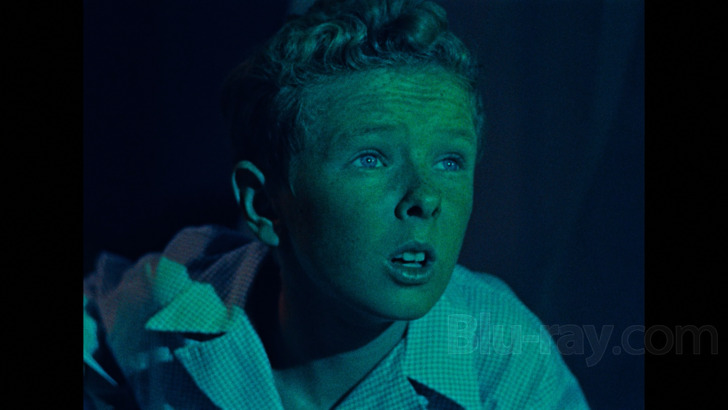
David Maclean (Jimmy Hunt) is a sweet little boy who wants to follow in the footsteps of his scientist father George (Leif Erickson), to the point that David sets his alarm for four in the morning in order to witness some rare astronomical event through his telescope. What he ends up seeing instead is a flying saucer crash landing into a nearby sand pit, an event which then sends the rest of the plot cartwheeling into motion. When David tells George what he's seen, George, obviously concerned, heads out to investigate and promptly disappears (at least for a little while). David's fraught mother Mary (Hillary Brooke) calls the police, but soon enough George comes back, though he's acting significantly differently than he did before and he has a weird little wound on his neck that David notices. Suffice it to say that George is not the only town resident to begin acting differently, and that burgeoning population soon includes Mary. What's a little boy to do?
Despite neighbors and even some authority figures now in the quasi-pod people camp, David finally finds a sympathetic ear belonging to Dr. Patricia Blake (Helena Carter, the actress who probably forced that other actress to use "Bonham" to differentiate herself), who in turn involves Dr. Stuart Kelston (Arthur Franz). Both of these characters become surrogate parents for David and in fact in one memorable scene actually keep David from being reclaimed by George and Mary. In the meantime, the military jumps into the fray, leading to a calamitous conclusion that is only partially undercut by some patently goofy representations of the Martians.
For such a relatively smaller budgeted affair, Invaders from Mars is almost relentlessly stylish, utilizing Menzies' decades of experience not just in set design but color theory and other "architectural" elements. Hunt is a really appealing presence, and if he and the adult actors aren't always helped by some clunky writing, the overall competence both on screen and perhaps especially behind the camera is really remarkable. The War of the Worlds probably understandably got the lion's share of the attention in 1953 when both films were screening, but Invaders from Mars has its own inimitable style and a really unsettling feeling of emotional instability.
Invaders from Mars 4K Blu-ray Movie, Video Quality 
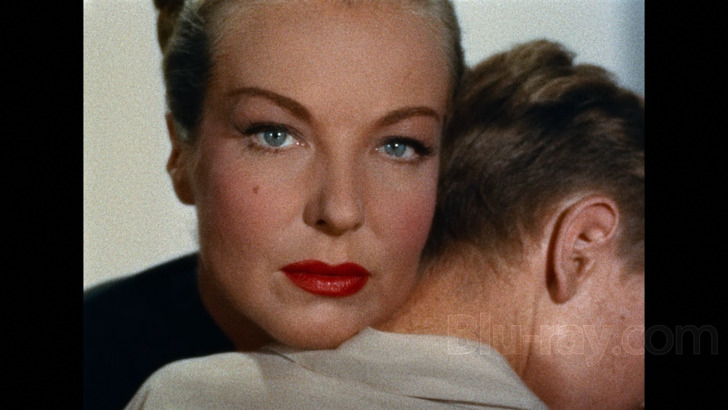
Note: Screenshots are sourced from Ignite's 1080 release. This release does not include a 1080 disc.
Invaders from Mars is presented in 4K UHD courtesy of Ignite Films with an HEVC / H.265 encoded 2160p transfer in 1.37:1. Let's just cut
to
the chase and borrow a phrase from an advertising staple that was probably at least in print media when this film was first released and say this
transfer is mmm, mmm, good, especially when considering some of the obstacles the restoration team was confronted with. Typically I try
to
include comments about restorations and/or transfers from insert booklets included with releases, but in this case, there are literally pages
of
information about the exhaustive efforts undertaken by Scott MacQueen and his cohort to get this film into largely pristine shape. Suffice it to say
that
while, yes, there are still some variances in densities, palette, grain and clarity, considering the glut of optical effects this feature has, the results are
amazingly homogeneous looking, though I'd argue some of the above mentioned variances are probably understandably more noticeable in this
version when compared to Ignite's 1080 release, given the
increased resolution of this format as well as the highlight nuances delivered courtesy of HDR. Anyone who had to suffer through at times relatively
appalling DVD releases of this film will be
immediately struck by
the healthiness of the palette in particular, which is now gorgeously suffused almost all of the time, with only some very minor downturns during
things
like dissolves. Scott MacQueen addresses some of the picayune color timing adjustments that were made in the featurette on the restoration
included
on the disc, and there's even more information in the insert booklet, but the bottom line is anyone who generally thinks of either Eastmancolor
and/or
CineColor as inherently "second rate" (at least when compared to Technicolor) may frankly be blown away by the lustrous quality of the palette. This
4K UHD version's HDR offers some subtle but noticeable highlights toward both the cool (as in the blue day for night sequences) and warm (virtually
all of the "naturally" lit material) sides of the spectrum. The greens throughout the whole climactic sequence have some kind of interesting jade like
highlights in this version as well. Detail
levels are also nicely improved throughout, even from already generally excellent levels in Ignite's 1080 release, again with an understanding that
some composited effects can lead to less clarity and a bit chunkier grain.
In the grain department, it's kind of refreshing to hear MacQueen admit up front that some "minor smoothing" was done when the team was
confronted
with dupes of dupes and were trying to cobble things together so that the grain field was more or less consistent. I'd argue they did a masterful job,
even if variances can be spotted. Any major signs of age related wear and tear have been eliminated, and while there is still some very minor lateral
wobble during the opening credits, otherwise any signs of instability have likewise been removed. I will simply close by saying this is what
film restoration should look like, and I can't imagine fans of this film not being over the moon (and/or Mars) with the results on tap.
Invaders from Mars 4K Blu-ray Movie, Audio Quality 

Invaders from Mars features DTS-HD Master Audio 2.0 Mono tracks in either English or Spanish. I frankly didn't spend a lot of time on the Spanish, but both it and the English track certainly show inherent signs of the recording technologies of the day, with a somewhat boxy sound that's probably most noticeable in either scoring or effects. That said, the overall track boasts a rather healthy midrange and low end, and all dialogue is delivered cleanly and clearly. Optional subtitles in several languages are available.
Invaders from Mars 4K Blu-ray Movie, Special Features and Extras 
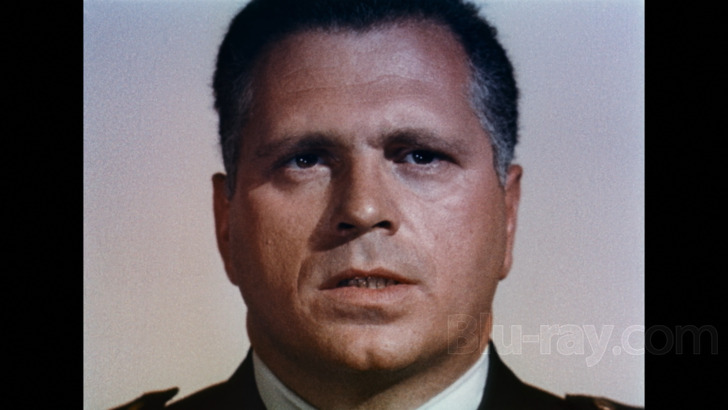
- William Cameron Menzies: Architect of Dreams (HD; 16:26) is an interesting piece mostly with James Curtis, author of William Cameron Menzies: The Shape of Films to Come. Menzies' granddaughter Pamela Lauesen joins Curtis relatively late for just a minute or two in a somewhat awkwardly staged but sweet reminiscence of her famous relative.
- Jimmy Hunt Saves the Planet (HD; 10:30) is a really fun interview with the now fully grown but still ebullient star of the film.
- Terror from Above (HD; 22:24) offers a compendium of notables who were influenced by the film rather early in their lives, including Joe Dante and John Landis. Preservationist Scott MacQueen, who's also on hand for the restoration featurette, offers comments as well.
- Restoring the Invasion (HD; 6:50) offers Scott MacQueen discussing the rather formidable hurdles that had to be overcome to offer this film in such generally superb shape.
- TCM Festival Introduction (HD; 7:02) features John Sayles, and may be a bit ironic considering some of the recent TCM news which may make screenings like this obsolete.
- European Observatory Sequence (HD; 8:51) is the additional and patently unnecessary sequence filmed (somewhat hilariously quite a bit after the initial shoot and in fact well after the film had debuted in the United States) in order to please foreign distributors with a longer running time. This comes with some initial explanatory text.
- European Ending (HD; 2:52) was another concession made to those pesky Europeans, who didn't like the "dreamy" aspect of the original ending.
- Theatrical Trailer (HD; 2:19)
- Re-release Trailer (HD; 2:17) is a really trip new piece done by Ignite, which made me wonder if someone from this Dutch company may have visited a "coffee shop" (or several) before producing this.
- Image Gallery (HD)
Note: Vis a vis nothing other than a tangential relationship to what is described in the featurette about Menzies and his control of the "entire look" of a film, some may feel that whoever designed this disc's menu was a fan of Arrow (see screenshot 20 of my Invaders from Mars Blu-ray review of the 1080 release).
Invaders from Mars 4K Blu-ray Movie, Overall Score and Recommendation 
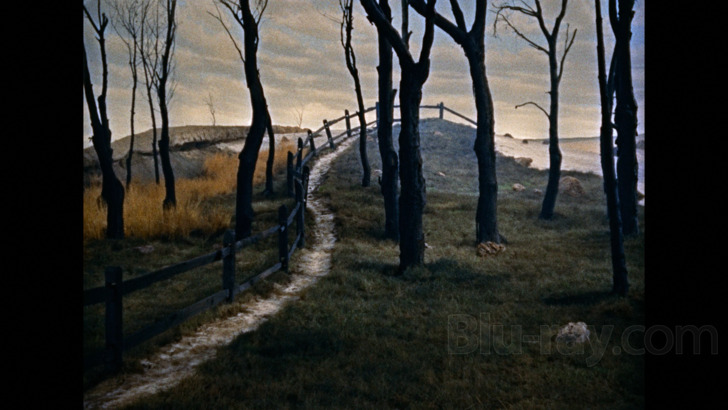
I was lucky to actually be able to see Invaders from Mars on the "big screen" at a Portland "art house" many years ago, and that print was in surprisingly good shape, but this new 4K version is simply revelatory in any number of areas. Ignite Films is off to a very impressive start with this release, and I can't wait for what they offer next. Technical merits are solid and the supplements very enjoyable. Highly recommended.
Other editions
Invaders from Mars: Other Editions

Invaders from Mars 4K
1953

Invaders from Mars 4K
Limited Edition | with Exclusive Poster Signed by Jimmy Hunt
1953

Invaders from Mars
Limited Edition | with Exclusive Poster Signed by Jimmy Hunt
1953

Invaders from Mars
1953

Invaders from Mars
Standard Edition
1953
Similar titles
Similar titles you might also like

The Thing from Another World
Warner Archive Collection
1951

Earth vs. the Flying Saucers
1956

It! The Terror from Beyond Space
2K Restoration
1958

The Blob 4K
1988

The War of the Worlds 4K
70th Anniversary
1953

Fiend Without a Face
1958

Invisible Invaders
1959

It Came from Outer Space 4K + 3D
Universal Essentials Collection
1953

Them!
1954

20 Million Miles to Earth
1957

The Quatermass Xperiment
Special Edition | The Creeping Unknown
1955

The Blob
1958

Quatermass 2
Enemy From Space
1957

Quatermass and the Pit
Five Million Years to Earth
1967

The Creep Behind the Camera / The Creeping Terror
1964

The Monolith Monsters
1957

Teenagers from Outer Space
1959

Big Ass Spider!
2013

The Giant Claw
1957

The Man from Planet X
1951